
(a)
Abstract:In order to analyze and evaluate the performance of the air suspension system of heavy trucks with semi-active fuzzy control, a three-dimensional nonlinear dynamical model of a typical heavy truck with 16-DOF (degree of freedom) is established based on Matlab/Simulink software. The weighted root-mean-square (RMS) acceleration responses of the vertical driver’s seat, the pitch and roll angle of the cab, and the dynamic load coefficient (DLC) are chosen as objective functions, and the air suspension system is optimized and analyzed by the semi-active fuzzy control algorithm when vehicles operate under different operation conditions. The results show that the influence of the roll angle of the cab on the heavy truck ride comfort is clear when vehicles move on the road surface conditions of the ISO level D and ISO level E at a velocity over 27.5 m/s. The weighted RMS acceleration responses of vertical driver’s seat, the pitch and roll angle of the cab are decreased by 24%, 30% and 25%, respectively, when vehicles move on the road surface condition of the ISO level B at a velocity of 20 m/s. The value of the DLC also significantly decreases when vehicles operate under different operation conditions. Particularly, the DLC value of the tractor driver axle is greatly reduced by 27.4% when the vehicle operates under a vehicle fully-loaded condition on the road surface condition of ISO level B at a velocity of 27.5 m/s.
Key words:heavy truck; dynamic model; air suspension; fuzzy logic control; dynamic load coefficient
One of the most important requirements of the heavy vehicles is to improve the ride comfort and road friendliness. In order to solve these problems, the heavy vehicle suspension system ought to be able to isolate the sprung mass from road-induced disturbances as well as reducing the dynamic load coefficient (DLC) of tire forces from the heavy vehicle axles within the limit of the working space under different operation conditions.
The passive suspensions were widely used in the heavy vehicles before. The air suspensions and semi-active suspensions are widely studied and improved due to their capability to consume less power and provide better ride quality. Many researchers have reported that using the semi-active suspensions for the vehicles can improve ride comfort and reduce dynamic tire forces[1-2].
Some control methods, such as the fuzzy logic control (FLC)[3-4], FLC-skyhook and FLC-PID control[5-6], FLC-Hinf, MR fluid damper and skyhook-NFLC control[7-9], are applied to adjust the damping coefficient of the vehicle suspension system. However, the quarter-car dynamic models are used in most of the research.
Yagiz et al.[10] used a half vehicle with 5-DOF and applied the FLC to control vehicle suspension. Yoshimura et al.[11]used a half vehicle with 6-DOF and applied the FLC-Skyhook damper to control active suspensions. Ieluzzi et al.[12] established a half-heavy truck model and applied the skyhook method to control the suspension system of the tractor driver. All the above research aims to improve vehicle ride comfort.
The air suspension system with air springs is chosen instead of conventional steel springs since air springs can effectively reduce the effect of the disturbance from the road input and also easily adjust to the ride height onboard. Buhari et al.[13]studied the effect of the air suspension of heavy trucks by comparing the dynamic load coefficient of tire forces with steel suspension, and showed that the DLC’s value was greatly decreased by air suspension. Xie et al.[14] applied the FLC-PID controller to control the semi-active air suspension of heavy vehicles by using the half-vehicle model and showed that the ride comfort and tire loads are significantly improved. All the proposed results show that the performance of the air suspension control system can not only increase ride comfort but also reduce road damage. However, the effect of the roll vibration of the full vehicle on ride comfort has not yet been considered in these studies.
This paper proposes a 3D dynamic model of a typical heavy truck with 16-DOF; the weighted RMS acceleration responses of vertical driver’s seat, the pitch and roll angle of the cab, and the dynamic load coefficient (DLC) value are chosen as the objective function; and a FLC program is developed based on Matlab/Simulink software. The semi-active fuzzy controller is then applied to control the damping coefficients of the air suspension system and the performance of the air suspension system is analyzed based on the objective functions when vehicles operate under different operation conditions.
1.1 Heavy truck dynamic model
A three-axle heavy truck with the dependent suspension systems for the steering axle, the tractor driver axle and the trailer axle is selected for vehicle dynamic analysis. A 3D model of vehicle with 16-DOF is established to analyze the performance of the air suspension system with semi-active fuzzy control (see Fig.1).

(a)

(b)
Fig.1 3D dynamic models of the three-axle heavy truck. (a) Side view; (b) Front view
In Fig.1, Zi are the vertical displacements at the centre of gravity of the driver’s seat, the cab, the tractor driver, the trailer and the axles; φ2, φ3, φ4 and θk are the angular displacements at the centre of gravity of the cab, the tractor driver, the trailer and the axles; mj are the sprung masses of the driver’s seat, the cab, the tractor driver and the trailer; ma1, ma2 and ma3 are the unsprung masses of the steering axle, the tractor driver axle and the trailer axle; Fs, Fcj and Fu are the dynamic reaction forces of the suspension systems of the driver’s seat, the cab, the tractor driver and the trailer; F0 is the dynamic reaction force of the articulation connection between the tractor driver and trailer; FTu are the dynamic reaction forces of the wheels; qu is the random road surface; lm, b1, b2 and b3 are the distances of the vehicle (i=1,2,…,7; j=1,2,3,4; k=2,3,…,7; u=1,2,…,6; m=1,2,…,8).
Based on the heavy truck dynamic model in Fig.1, Newton’s second law is chosen in this study. The general dynamic differential equation for the three-axle heavy truck is given by the following matrix form:
(1)
where Z is the vector of displacement; M is the mass matrix; C is the damping matrix of the suspension system; K is the stiffness matrix of the suspension system; CT is the damping matrix of the wheel system; KT is the stiffness matrix of the wheel system; Q is the vector of excitation of the road surface.
1.2 Semi-active controlled air suspension model
The suspension systems of the tractor driver and the trailer are used by the rolling lobe air springs and viscous dampers which are controlled by semi-active fuzzy control, as shown in Fig.2.

(a)
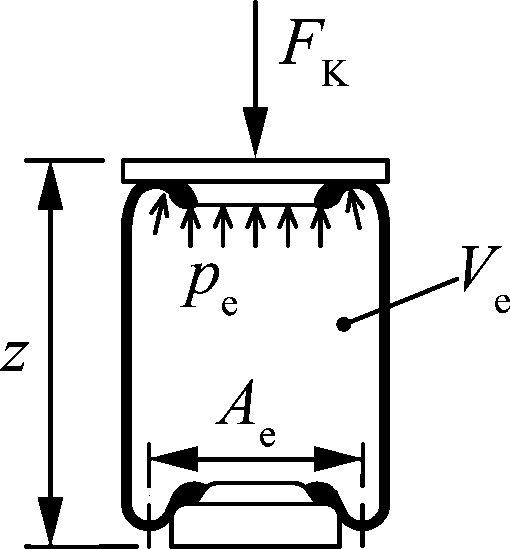
(b)
Fig.2 Air suspension model. (a) Semi-active air suspension; (b) Air spring
In Fig.2(a), the equation of dynamic reaction forces of the air suspension system can be written as where K is the air spring stiffness coefficient; Cp is the passive damping coefficient; Csemi is the semi-active damping coefficient; z=zu-zb and ![]() b are the relative displacement and velocity of the air suspension.
b are the relative displacement and velocity of the air suspension.
(2)
The air spring stiffness coefficient K is determined based on the experimental data and the laws of the thermodynamics method[14]. In this study, the air spring stiffness coefficient is calculated by a new method based on the variation of volume, area, and other structural parameters of the interior air spring.
The air spring stiffness can thus be obtained by the derivative of ratio elastic force and the displacement of the air spring, as shown in Fig.2(b), as follows:
(3)
The effective volume and area are defined as
Ve=V0-α1z, Ae=A0+α2z
(4)
Based on the laws of thermodynamics[15], if the compression or expansion stroke of the air spring changes quickly, it can be regraded to be an adiabatic process. Thus, the air state of the air spring can be defined as
(5)
where Ve, Ae and z are the effective volume, area and the instantaneous height variation of air spring; V0 and A0 are the initial effective volume and area; α1 and α2 are the change of Ve and Ae with respect to z; p0, pe are the air pressures of initial and final state; pa is the standard atmospheric pressure (0.1 MPa); and n is the specific heat ratio (n=1.33).
Substituting Eqs.(4) and (5) into Eq.(3) and applying Eq.(3) for the stiffness of air springs, we have
(6)
where l=1 when i=1, 2; l=3 when i=3,4,5,6.
The FLC was created by Zadeh in 1965. It has been widely applied in various situations and fields. The fuzzy logic-based control for semi-active suspension of vehicle is proposed and the capability for the improvement of ride comfort are studied by simulation. In this study, in order to control the semi-active air suspension system, six passive air suspension systems should be controlled separately. Thus, six different fuzzy controllers are designed. However, the design process of these controllers are the same, thus a specific fuzzy control is designed and applied to control the air suspension system.
The FLC consists of a fuzzification interface, a fuzzy inference system and a defuzzification interface. First, the crisp values in fuzzification are transformed into linguistic variables. The fuzzy inference system is then used by the fuzzy rule in accordance with the inference rule. Finally, the linguistic variables are transformed back to crisp values through defuzzification[3-4]. In this study, the relative displacement z and the relative velocity ![]() are considered as two input variables, while the damping coefficient Csemi is the output of the semi-active fuzzy controller.
are considered as two input variables, while the damping coefficient Csemi is the output of the semi-active fuzzy controller.
The nine linguistic variables of input and output variables are defined, such as the positive very big (PVB), positive big (PB), positive medium (PM), positive small (PS), zero (Z), negative small (NS), negative medium (NM), negative big (NB), negative very big (NVB) and yi (i=1,2,…,9).
The membership functions for input and output variables of the semi-active air suspension system are represented by a fuzzy set. The shape of membership functions is the triangular function and the value of the degree of memberships (DOM) is between 0 and 1, as shown in Fig.3.

(a)

(b)

(c)
Fig.3 Membership functions for input and output variables of the air suspension system. (a) z; (b)  ; (c) Csemi
; (c) Csemi
In this fuzzy controller, the if-then rules are applied to describe the relationship of z, ![]() and Csemi according to the designer’s knowledge and experience. There are at most 81 possible rules, and the fuzzy rules are given in Tab.1.
and Csemi according to the designer’s knowledge and experience. There are at most 81 possible rules, and the fuzzy rules are given in Tab.1.
Tab.1 Rules for fuzzy control
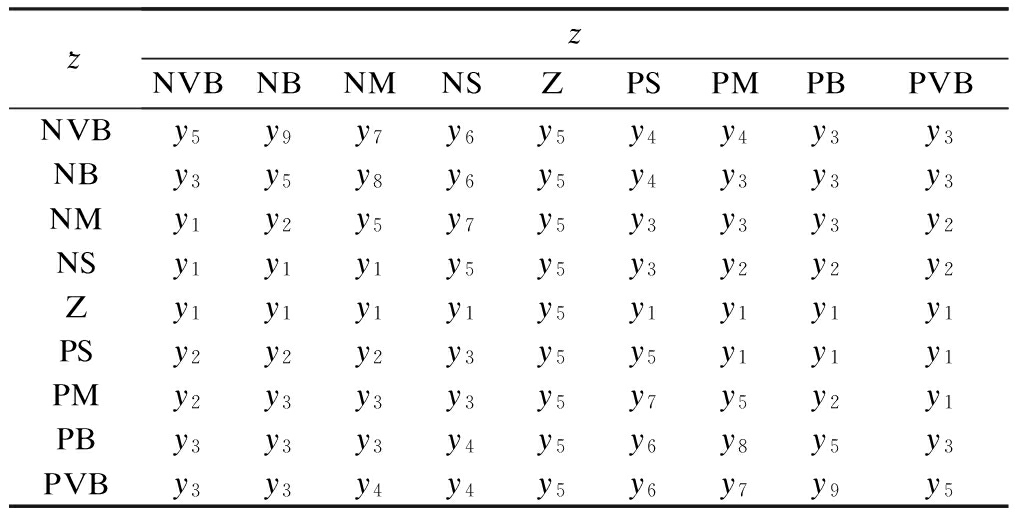
zzNVBNBNMNSZPSPMPBPVBNVBy5y9y7y6y5y4y4y3y3NBy3y5y8y6y5y4y3y3y3NMy1y2y5y7y5y3y3y3y2NSy1y1y1y5y5y3y2y2y2Zy1y1y1y1y5y1y1y1y1PSy2y2y2y3y5y5y1y1y1PMy2y3y3y3y5y7y5y2y1PBy3y3y3y4y5y6y8y5y3PVBy3y3y4y4y5y6y7y9y5
The fuzzy inference system is selected by the minimum function and the centroid method of Karray and Mamdani et al[16-17]. In this paper, the fuzzy inference system of Mamdani is used to control the air suspension systen model.
3.1 Basic evaluation method
According to the international standard ISO 2631-1[18], the effect of vibration on driver ride comfort is evaluated based on the weighted root-mean-square (RMS) acceleration response, which is defined as
(7)
where awt is the acceleration (translational and rotational) depending on the time of measurement T.
The weighted RMS acceleration responses of the vertical driver’s seat aws, the pitch and roll angle of the cab, awpc and awrc, can be calculated from Eq.(7), and the results are compared with awz, as given in the international standard ISO 2631-1.
3.2 Dynamic load coefficient
The DLC is frequently used to characterize dynamic loading of axles and it is defined as[13]
(8)
where FT,rmsis the RMS of the vertical dynamic wheel load, and Fst is the average vertical wheel load.
The DLC’s value is in the range of 0.05 to 0.3 under normal operation conditions. The DLC’s value can reduce to zero when the wheel moves on a special smooth road or increases up to 0.4 when the wheel-road contact is broken[19]. In this study, the dynamic load coefficient is used to analyze the vehicle-road interaction.
The road surface is a random excitation, which impacts not only on vehicle-road interaction but also on the vehicle’s fatigue life. The random excitation of road surface roughness can be represented by a randomly modulated periodic. The general form of the displacement power spectral density (PSD) of road surface roughness is determined by the experimental formula[20]:
(9)
where n is the space frequency; n0 is the reference space frequency, n0=0.1 m-1; Gq(n) is the road roughness constant or PSD of the road surface under the reference space frequency n0; ω is the frequency index which determines the frequency configuration of the PSD of the road surface (ω=2 rad/s). The random road is assumed to be a zero-mean stationary Gaussian random process, and it can be generated by the Fourier transformation as
![]() φi)
φi)
(10)
where φi is the random phase uniformly distributed from 0 to 2π.
According to the standard ISO/TC 8068[20], the road surface roughness is established in this study.
The purpose of this study is to analyze the performance of the air suspension system based on the objective functions when vehicles operate under different operation conditions. The parameters of the three-axle heavy vehicle is given in Tab.2.
5.1 Simulation control air suspension system
In order to control the air suspension system of heavy trucks with the semi-active fuzzy control, simulations are carried out when vehicles operate under different operation conditions. The simulation results of the acceleration responses of driver’s seat, the pitch and roll angle of the cab when vehicles move on the road surface condition of ISO level B at v=20 m/s are shown in Fig.4.
Tab.2 Parameters of the three-axle heavy truck[21]
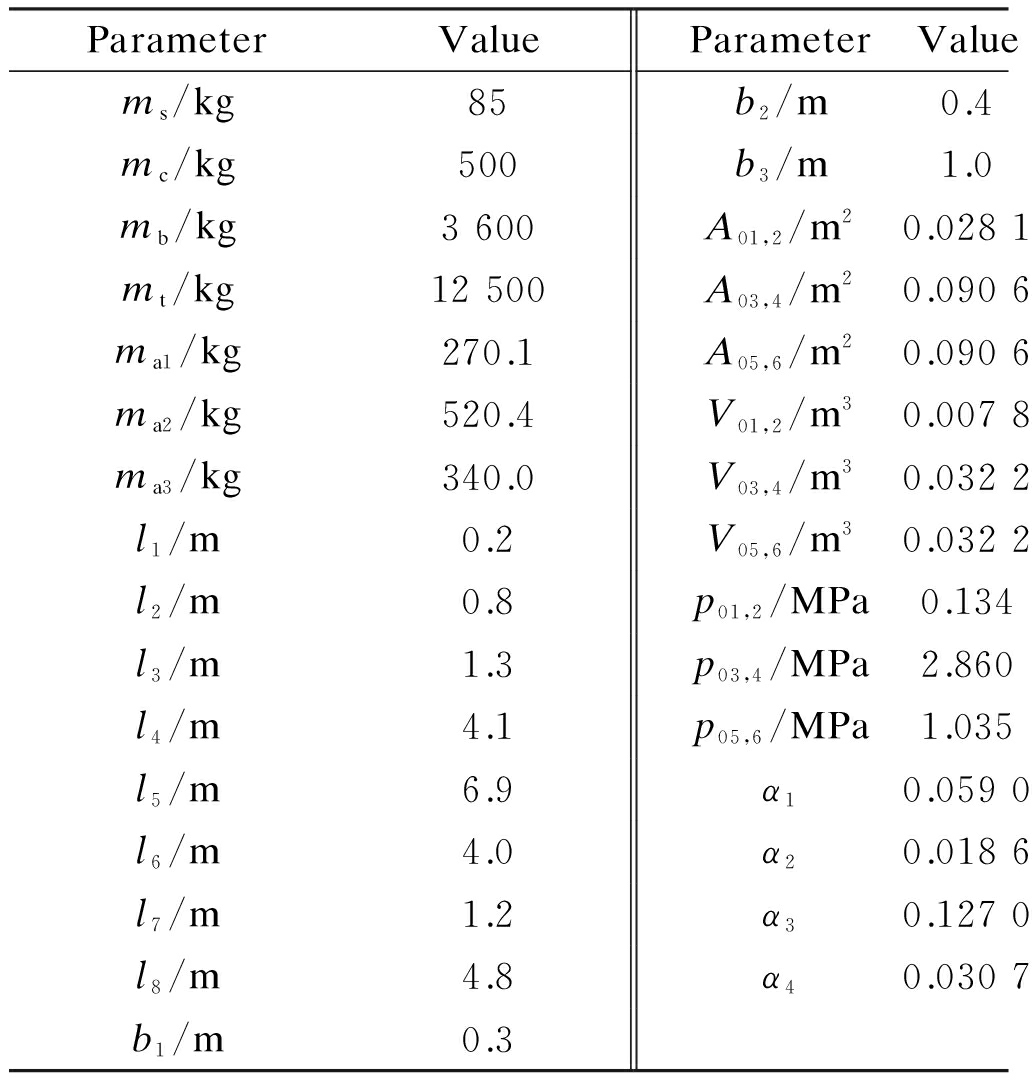
ParameterValueParameterValuems/kg85b2/m0.4mc/kg500b3/m1.0mb/kg3600A01,2/m20.0281mt/kg12500A03,4/m20.0906ma1/kg270.1A05,6/m20.0906ma2/kg520.4V01,2/m30.0078ma3/kg340.0V03,4/m30.0322l1/m0.2V05,6/m30.0322l2/m0.8p01,2/MPa0.134l3/m1.3p03,4/MPa2.860l4/m4.1p05,6/MPa1.035l5/m6.9α10.0590l6/m4.0α20.0186l7/m1.2α30.1270l8/m4.8α40.0307b1/m0.3
With the passive air suspension system of heavy trucks, the weighted RMS acceleration response of the cab roll angle is increased by 16.6% in comparison with the cab pitch angle (see Fig.4(c) and Tab.3). Thus, the roll angle of the cab clearly affects ride comfort and driver’s health.
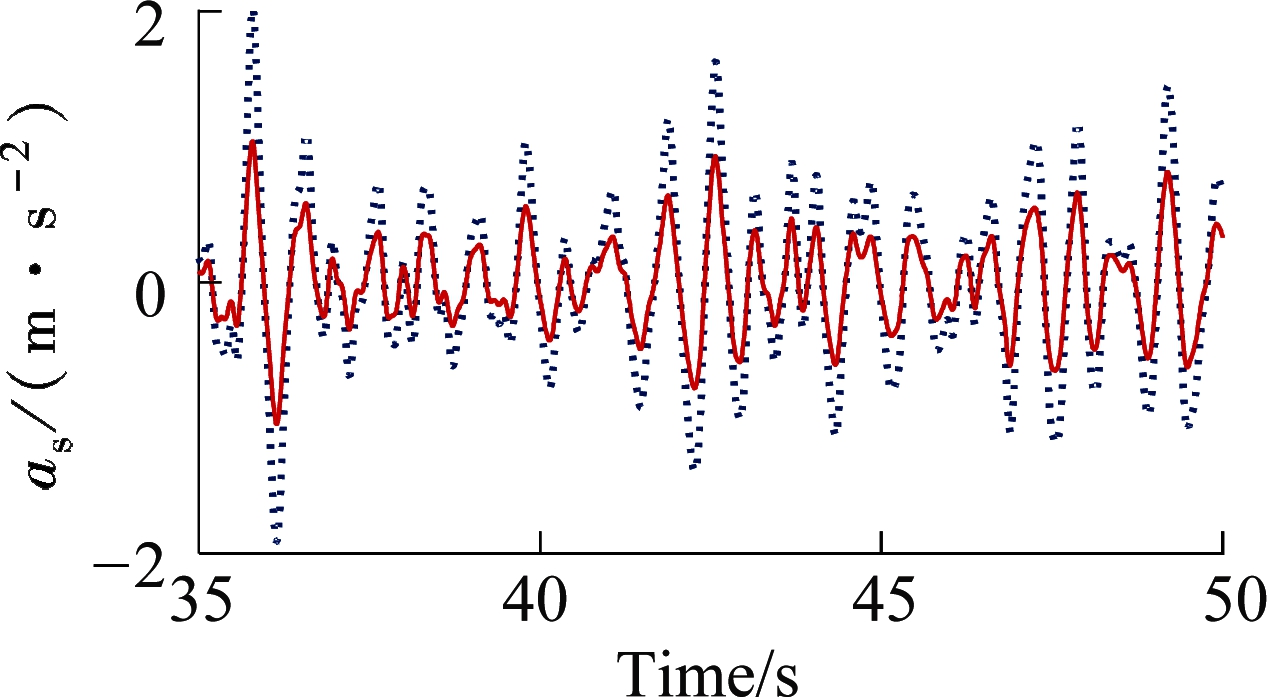
(a)
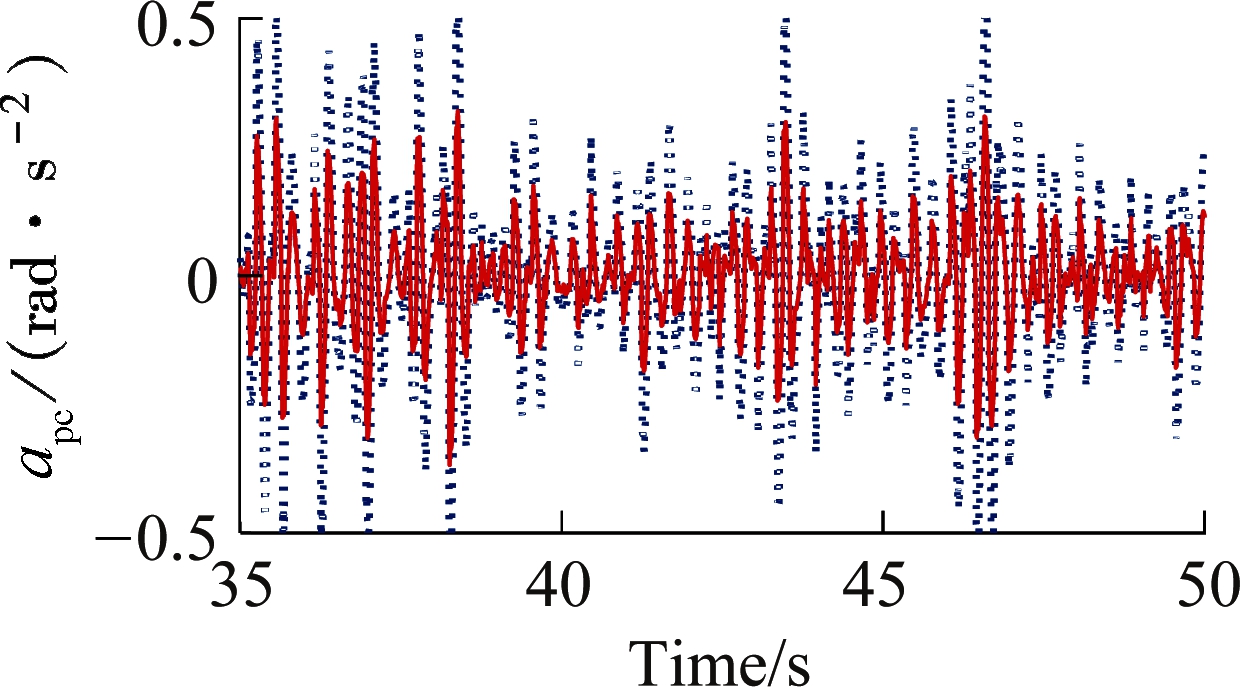
(b)
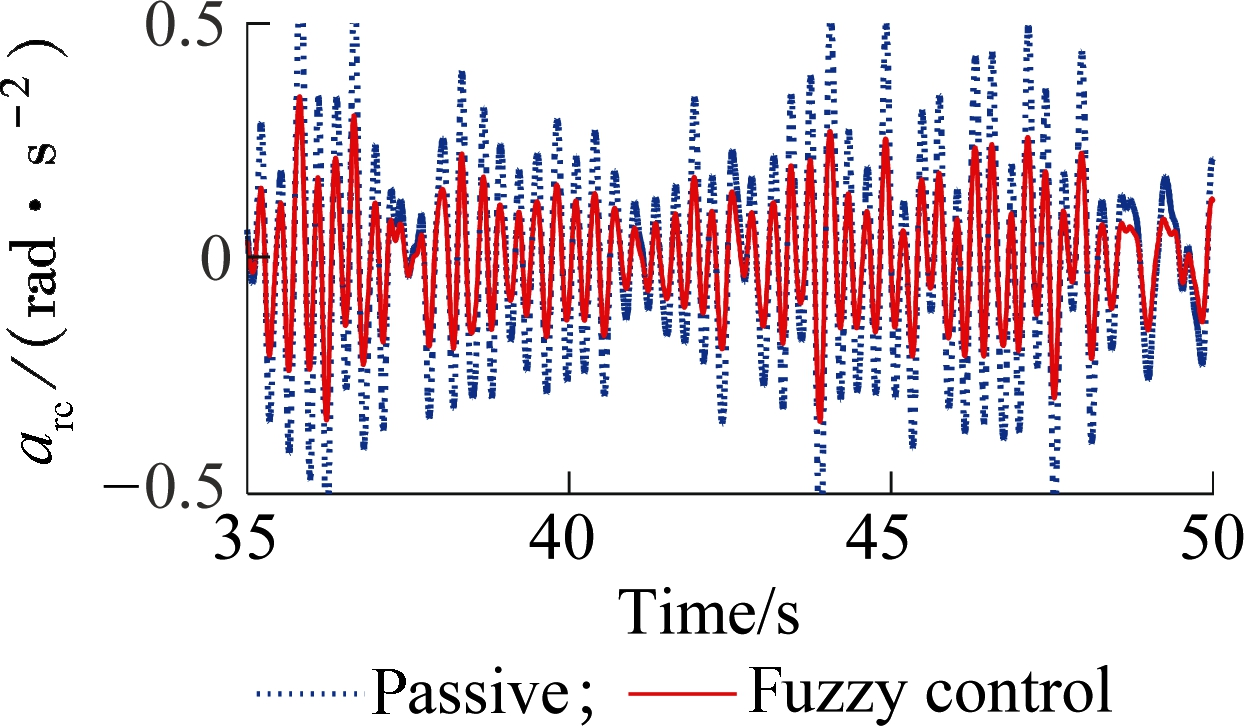
(c)
Fig.4 The accelerations of the driver’s seat and cab. (a) Driver’s seat heave; (b) Cab pitch angle; (c) Cab roll angle
Tab.3 Control performance with the fuzzy control

ParametersPassiveFuzzycontrolReduction/%aws/(m·s-2)0.420.3224.0awpc/(rad·s-2)0.100.0730.0awrc/(rad·s-2)0.120.0925.0DLC0.090.0722.2FT,rms/kN4.623.5124.0
The air suspension system is controlled by the semi-active fuzzy control, as shown in Figs.4(a), (b) and (c), the acceleration responses of the driver’s seat, the pitch and roll angle of the cab are reduced in comparison with the passive air suspension system. The results in Tab.3 show that the weighted RMS acceleration responses of the driver’s seat, the pitch and roll angle of the cab are significantly reduced by 24%, 30% and 25%. According to the standard ISO 2631-1[18], the driver feels a little uncomfortable. The DLC’s value and the RMS dynamic tire forces on the tractor driver axle are also decreased by 22.2% and 24.0% in comparison with the passive air suspension system. Consequently, the air suspension system of heavy truck with the semi-active fuzzy control not only increases the ride comfort but also reduces the road damage.
5.2 Effect of road surface roughness
Five road conditions from Level A (very good) to Level E (very poor) in ISO/TC 8068[20] are chosen to simulate and analyze the effect of road surface roughness on the air suspension system of heavy trucks at v=20 m/s.
Fig.5 shows that compared with the cab pitch angle, the weighted RMS acceleration response of the cab roll angle is increased with the passive air suspension system. Specifically, the weighted RMS acceleration response of the roll angle of the cab is increased by 25.5% and 30.8% on the road surface conditions of ISO level D and ISO level E. Thus, the influence of the roll angle of the cab on the heavy truck ride comfort is very clear.
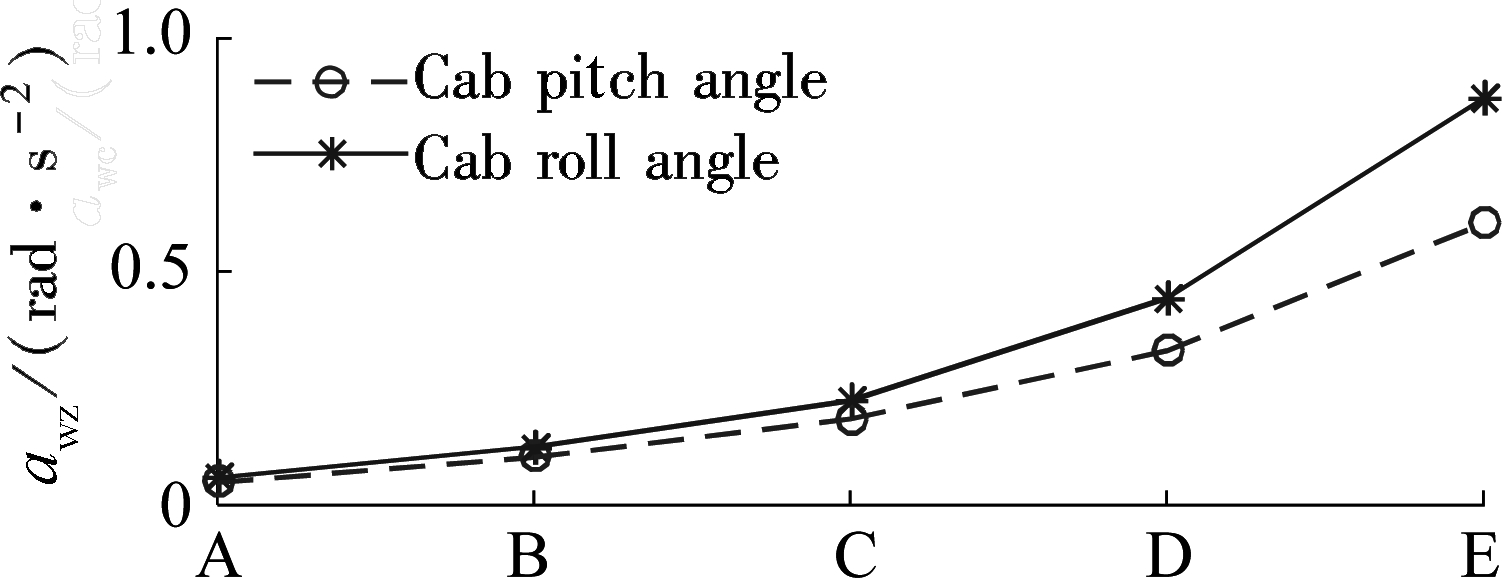
Fig.5 Weighted RMS acceleration responses of cab pitch and roll angle with the passive air suspension system
The simulation results in Tab.4 show that the weighted RMS acceleration responses of the vertical driver’s seat, the pitch and roll angle of the cab are significantly reduced in the air suspension system of heavy trucks with semi-active fuzzy control; particularly, when vehicles move on the road surface condition of ISO Level B. They decrease by 24%, 30% and 25%, respectively. However, the weighted RMS acceleration responses of driver’s seat on ISO Level E road surfaces is increased by 3.8%.
Tab.4 Percentage reduction of weighted RMS acceleration responses %

ParametersRoadsurfaceroughnessLevelALevelBLevelCLevelDLevelEaws12.324.012.023.8-3.8awpc24.030.017.016.410.7awrc25.025.016.713.9 3.2
Fig.6 shows that the DLC’s values of dynamic tire forces at each axle are significantly reduced in comparison with those of the passive air suspension system, particularly at the tractor driver axle. However, the values at the tractor driver axle are the maximum and thus the impact on road damage is also the greatest.

Fig.6 The DLC’s values of dynamic tire forces on different road surfaces
The results in Tab.5 also show that the maximum DLC’s values at the tractor axle of the air suspension system with semi-active fuzzy control on road surface conditions from ISO level A to ISO level D are 0.03 to 0.25. Thus, the DLC’s value is under normal operation conditions[18-19]. However, the DLC’s value is greatly increased by 0.47 when vehicles move on road surface under the condition of ISO Level E, and when the wheels-road contact of the tralor driver axle is broken.
Tab.5 Results of DLC on the tractor axle

RoadsurfaceDLCPassiveFuzzycontrolReduction/%LevelA0.040.0325.0LevelB0.090.0722.2LevelC0.180.1327.7LevelD0.290.2513.8LevelE0.520.479.6
5.3 Effect of vehicle velocity
A range of vehicle velocities under different loading conditions (half-loaded, fully-loaded and over-loaded vehicles) on the road surface of ISO Level B is chosen to simulate and analyze the performance of FLC.
Figs.7(a), (b) and (c) show that the weighted RMS acceleration responses of the driver’s seat, the pitch and roll angle of the cab are significantly decreased in comparison with those of the passive air suspension system under different loading conditions. When the vehicle velocities range from 10 to 12.5 m/s, the weighted RMS acceleration response of the roll angle of the cab is greatly decreased. Meanwhile, the weighted RMS acceleration response of the pitch angle is slightly decreased. It is found that the weighted RMS acceleration responses of the driver’s seat, the pitch and roll angle of the cab are significantly reduced at velocities from 17.5 to 20 m/s. This implies that dirver’s ride comfort is significantly improved. In fact, the weighted RMS acceleration responses of the pitch and roll angle of the cab increase at a velocity of 27.5 m/s in both the passive and semi-active air suspension systems.

(a)
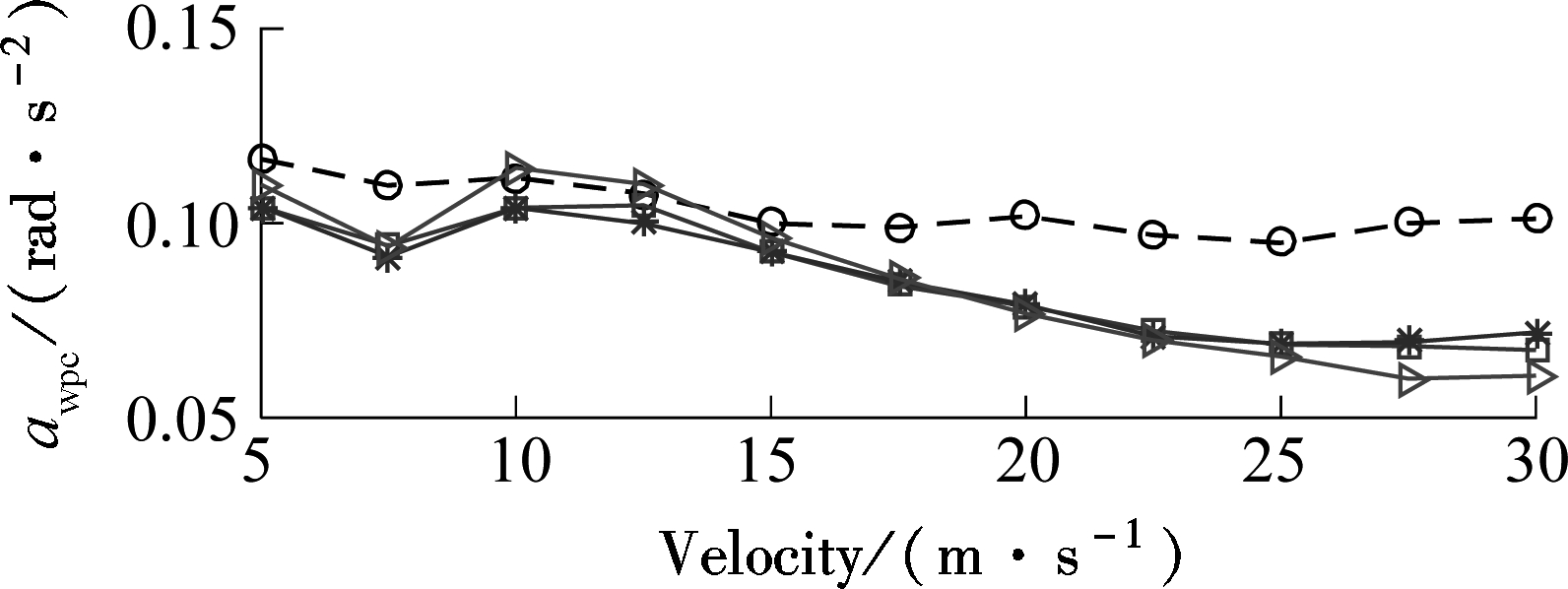
(b)
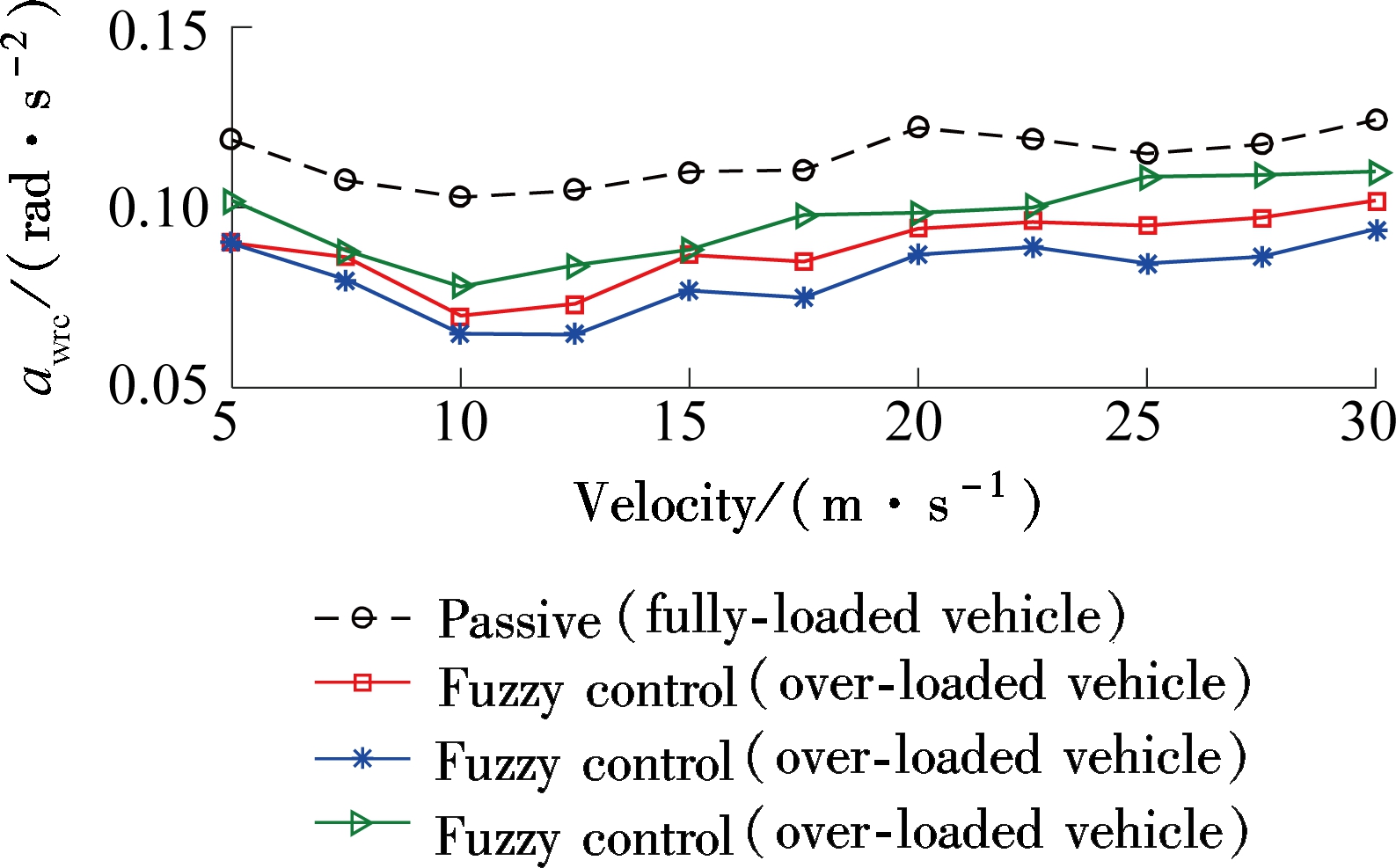
(c)
Fig.7 Weighted RMS acceleration responses of the vertical driver’s seat and the angles of the cab. (a) Driver’s seat heave; (b) Cab pitch angle; (c) Cab roll angle
As shown in Fig.8, the DLC’s value is increased when the vehicle operates under the fully-loaded condition with a passive air suspension system.
When vehicles operate under the same condition, the DLC’s value is significantly reduced by the air suspension system with the semi-active fuzzy control. The maximum DLC’s are reduced by 17.9%, 22.2% and 27.4%, respectively, when vehicles move on the road surface condition of ISO Level B at 7.5, 20 and 27.5 m/s. In addition, the DLC’s value strongly depends on the loading conditions. The value of DLC is greatly increased in
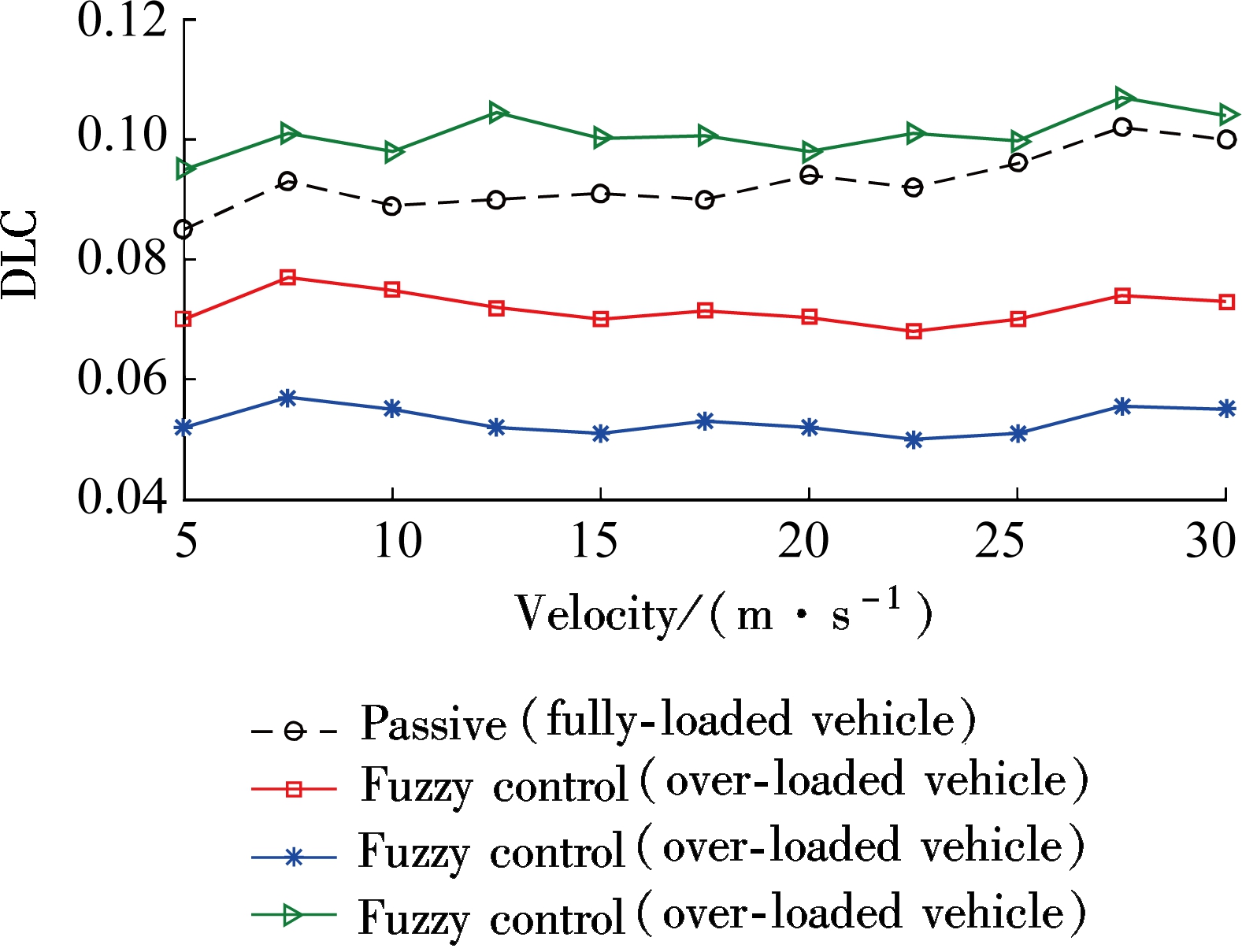
Fig.8 The DLC’s values on the tractor driver axle
the case of the half-loaded vehicle and it is also greatly reduced in the case of the over-loaded vehicle in comparison with the fully-loaded vehicle.
1) The influence of the cab roll angle on the heavy truck ride comfort is clear when vehicles move on the road surface conditions of ISO Level D and ISO Level E at a velocity of over 27.5 m/s.
2) The weighted RMS acceleration responses of the vertical driver’s seat, the pitch and roll angle of the cab are greatly decreased by 24%, 30%, 25% and slightly decreased by -3.8%, 10.7% and 3.2%, respectively, when vehicles move on the road surface conditions of ISO Level B and ISO Level E at a velocity of 20 m/s.
3) The DLC’s value is also significantly decreased when vehicles operate under different operation conditions. Specifically, the DLC’s value of the tractor driver axle is reduced by 27.4% when vehicles operate under full-loading conditions on the road surface condition of ISO Level B at a velocity of 27.5 m/s.
[1]Guglielmino E, Edge K A, Stammers C W. Robust force control in electrohydraulic friction damper systems using a variable structure scheme with non-linear state feedback [C]//2nd Internationales Fluidtechnisches Kolloquium. Dresden, Germany, 2000: 163176.
[2]Choi S B, Lee S K, Park Y P. A hysteresis model for the field-dependent damping force of a magnetorheological damper [J]. Journal of Sound and Vibration, 2001, 245(2): 375-383. DOI:10.1006/jsvi.2000.3539.
[3]Rao M V C, Prahlad V. A tunable fuzzy logic controller for vehicle-active suspension systems [J]. Fuzzy Sets and Systems, 1997, 85(1): 11-21. DOI:10.1016/0165-0114(95)00369-x.
[4]Mamdani E H, Assilian S. An experiment in linguistic synthesis with a fuzzy logic controller [J]. International Journal of Man-Machine Studies, 1975, 7(1): 1-13. DOI:10.1016/s0020-7373(75)80002-2.
[5]Pekgökgöz R K, Gürel M A, Bilgehan M, et al. Active suspension of cars using fuzzy logic controller optimized by genetic algorithm [J]. International Journal of Engineering and Applied Science, 2010, 2(4): 27-37.
[6]Chen Y, Wang Z L, Qiu J, et al. Hybrid fuzzy skyhook surface control using multi-objective microgenetic algorithm for semi-active vehicle suspension system ride comfort stability analysis [J]. Journal of Dynamic Systems, Measurement, and Control, 2012, 134(4): 041003. DOI:10.1115/1.4006220.
[7]Félix-Herrán L C, Mehdi D, de Rodríguez-Ortizc J D J, et al. Hinf control of a suspension with a magnetorheological damper [J]. International Journal of Control, 2012, 85(8): 1026-1038. DOI:10.1080/00207179.2012.674216.
[8]Nguyen S D, Nguyen Q H, Choi S B. A hybrid clustering based fuzzy structure for vibration control—Part 2: An application to semi-active vehicle seat-suspension system [J]. Mechanical Systems and Signal Processing, 2015, 450(56/57): 288-301. DOI:10.1016/j.ymssp.2014.10.019.
[9]Li C, Zhao Q. Fuzzy control of vehicle semi-active suspension with MR damper [C]//2010 WASE International Conference on Information Engineering. Beidaihe, China, 2010, 10: 426-428. DOI: 10.1109/ICIE.2010.279.
[10]Yagiz N, Sakman L E, Guclu R. Different control applications on a vehicle using fuzzy logic control [J]. Indian Academy of Sciences, 2008, 33(1): 15-25. DOI:10.1007/s12046-008-0002-9.
[11]Yoshimura T, Isari Y, Li Q, et al. Active suspension of motor coaches using skyhook damper and fuzzy logic control [J]. Control Engineering Practice, 1997, 5(2): 175-184. DOI:10.1016/s0967-0661(97)00224-4.
[12]Ieluzzi M, Turco P, Montiglio M. Development of a heavy truck semi-active suspension control [J]. Control Engineering Practice, 2006, 14(3): 305-312. DOI:10.1016/j.conengprac.2005.03.019.
[13]Buhari R, Rohani M M, Abdullah M E. Dynamic load coefficient of tyre forces from truck axles [J]. Applied Mechanics and Materials, 2013, 405-408: 1900-1911. DOI:10.4028/www.scientific.net/amm.405-408.1900.
[14]Xie Z C, Wong P K, Zhao J, et al. A noise-insensitive semi-active air suspension for heavy-duty vehicles with an integrated fuzzy-wheelbase preview control [J]. Mathematical Problems in Engineering, 2013, 2013: 1-13. DOI:10.1155/2013/121953.
[15]Fox M N, Roebuck R L, Cebon D. Modelling rolling-lobe air springs [J]. International Journal of Heavy Vehicle Systems, 2007, 14(3): 254-270. DOI:10.1504/ijhvs.2007.015603.
[16]Karray F O, de Silva C W. Soft computing and intelligent systems design: Theory, tools, and application [M]. New York, USA: Addison Wesley, 2014.
[17]Mamdani E H. Advances in the linguistic synthesis of fuzzy controllers[J]. International Journal of Man-Machine Studies, 1976, 8(6): 669-678. DOI:10.1016/s0020-7373(76)80028-4.
[18]International Organization for Standardization. ISO 2631-1 Mechanical vibration and shock—Evaluation of human exposure to wholebody vibration—Part 1: General requirements [S]. Geneve, Switzerland: International Organization for Standardization, 1997.
[19]Cole D J, Cebon D. Truck suspension design to minimize road damage [J]. Proceedings of the Institute of Mechanical Engineers, Part D: Journal of Automobile Engineering, 1996, 210(2): 95-107.
[20]International Organization for Standardization. ISO 8068 Mechanical vibration—Road surface profiles—Reporting of measured data [S]. Geneve, Switzerland: International Organization for Standardization, 1995.
[21]Tsampardoukas G, Stammers C W, Guglielmino E. Hybrid balance control of a magnetorheological truck suspension [J]. Journal of Sound and Vibration, 2008, 317(3/4/5): 514-536. DOI:10.1016/j.jsv.2008.03.040.
References:
摘要:为了分析和评价具有半主动模糊控制的重型卡车空气悬挂系统性能,基于Matlab/Simulink软件建立了具有16自由度的三维非线性动力学模型.以座椅的平均垂直加速度响应、驾驶室的俯仰和倾斜角及动载系数(DLC)为目标函数,用半主动模糊控制方法对不同工况下的车辆空气悬挂系统进行了优化分析.结果表明:在ISO D级和ISO E级路面上,当车速超过27.5 m/s时,驾驶室侧倾角对重型卡车乘坐舒适性影响非常明显;在ISO B级路面车速为20 m/s时,车辆座椅的平均垂向加速度、驾驶室俯仰角及驾驶室倾侧角分别降低了24%,30%和25%.此外,在不同路况条件下,车辆的动载系数均有较大的降低.特别地,在ISO B级路面车速为27.5 m/s且满载时,车辆驱动轴处的动载系数降低了27.4%.
关键词:重型卡车;动力学模型;空气悬架;模糊逻辑控制;动载系数
中图分类号:U461.3
Received:2016-12-01.
Foundation item:s:The Science and Technology Support Program of Jiangsu Province (No.BE2014133), the Prospective Joint Research Program of Jiangsu Province (No.BY2014127-01).
Citation::Nguyen Van Liem, Zhang Jianrun, Le Van Quynh, et al. Performance analysis of air suspension system of heavy truck with semi-active fuzzy control[J].Journal of Southeast University (English Edition),2017,33(2):159-165.
DOI:10.3969/j.issn.1003-7985.2017.02.006.
DOI:10.3969/j.issn.1003-7985.2017.02.006
Biographies:Nguyen Van Liem (1986—), male, graduate; Zhang Jianrun (corresponding author), male, doctor, professor, zhangjr@seu.edu.cn.